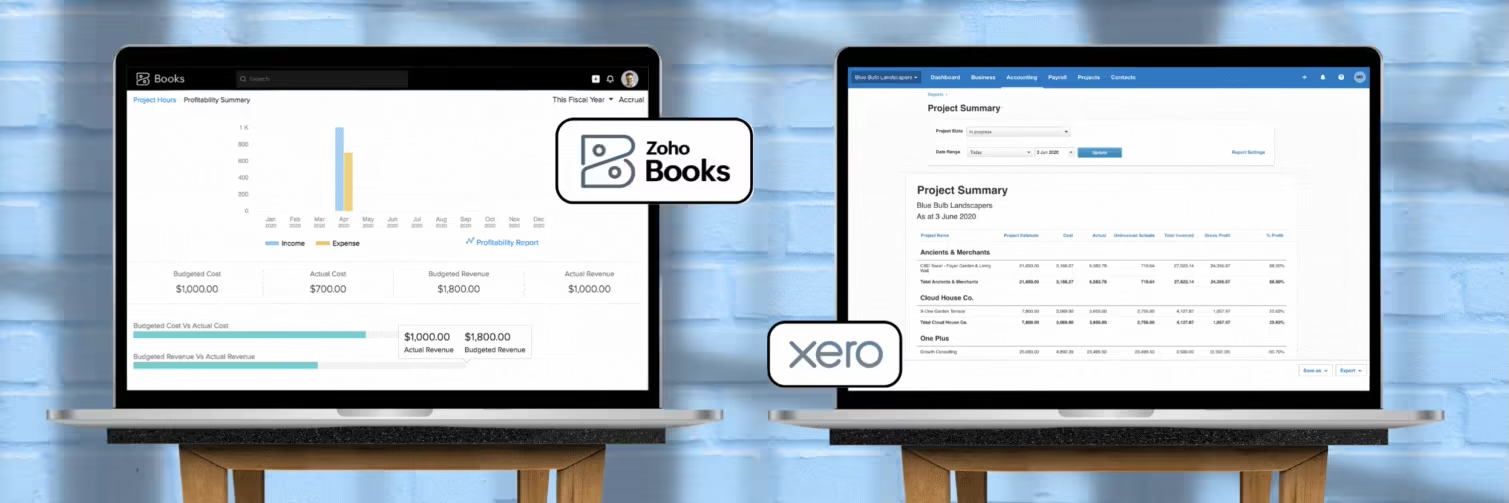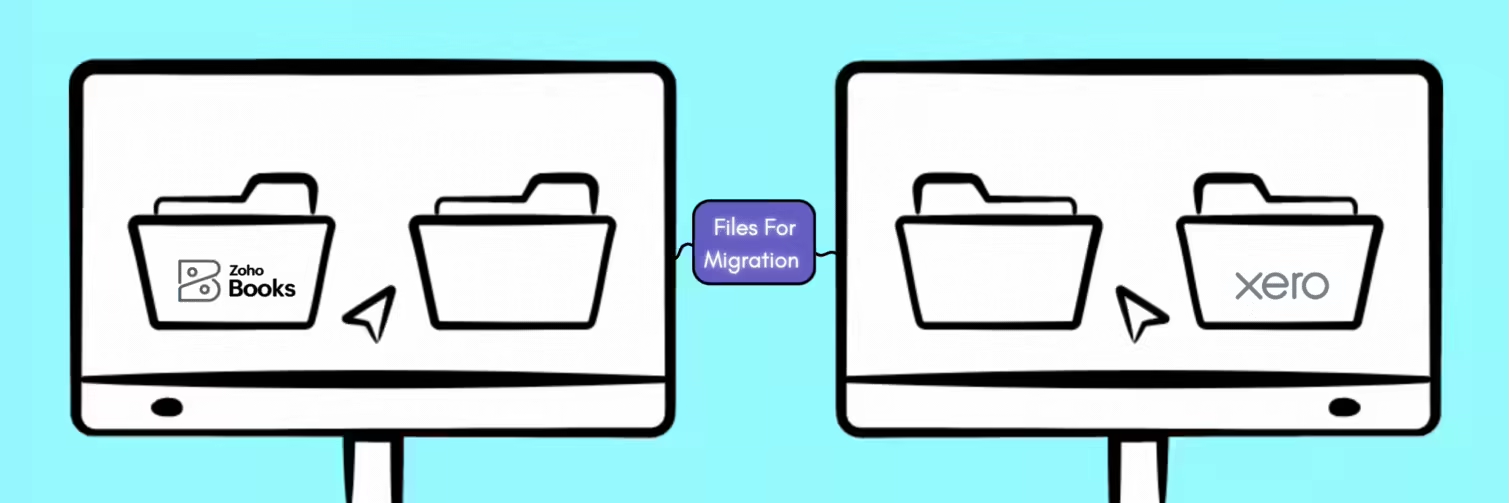Table of Content
Share This Article
- Published: Jul 23, 2025
- Last Updated: Aug 2, 2025
Key Takeaways
- Choosing the right accounting software is important for business success, and Zoho Books vs Xero is a common and important comparison.
- Both Zoho Books and Xero are leading cloud accounting platforms, offering strong financial management tools tailored for different business needs.
- When it comes to invoicing, Zoho Books offers more built-in automation and customisation, including a client portal and automated payment reminders.
- Xero's bank reconciliation prioritises speed and AI-assisted matching with direct Open Banking integrations, though some details require extra clicks.
- In terms of integrations, Zoho Books excels within its own ecosystem like CRM, Inventory, etc, with decent third-party connections.
- Transitioning to either platform requires setting a clear cut-off date, cleaning up old accounts, and following a structured setup process for consistency and accuracy.
- Hiring experienced virtual accountants ensures seamless setup, precise data transfer, and compliance maximising the value of your new accounting software.

Zoho Books, Expertly Handled
Scale Smart With Pro Zoho Services
Choosing the right accounting software is crucial for any business, especially with so many strong contenders available. One of the most common comparisons business owners make is Zoho Books vs Xero. Both are popular platforms offering robust features for managing finances from invoicing to reporting but they cater to slightly different needs. In this blog, we will dive into a detailed comparison of Zoho Books vs Xero, helping you decide which platform is the perfect fit for your business’s unique financial workflow.
Which Software is Ideal for Small, Medium, and Large Enterprises?
Both Zoho Books and Xero are leading cloud-based accounting software, but each has strengths that make it ideal for specific business sizes and needs. Here is how they compare for small, medium, and large enterprises:
Small Enterprises
- Zoho Books
- Xero:
- Zoho Books
- Xero
- Zoho Books
- Xero
Zoho Books is especially well-suited for small businesses and startups due to its affordability, simplicity, and functionality. It offers essential features like invoicing, expense tracking, bank reconciliation, and VAT compliance in an easy-to-use interface. What is more, Zoho Books provides a forever-free plan for businesses with an annual turnover under £35,000 making it an excellent option for micro-businesses or sole proprietors. However, user access is limited depending on the pricing plan, which could be a limitation if your team starts to grow quickly.
Xero is also user-friendly and aims to serve small businesses with simple onboarding, smart financial features, and an intuitive design. One major advantage is unlimited user access, even in its lowest tier paid plans, making it a better option for collaboration if you want multiple users working on the system simultaneously. While it doesn’t offer a free plan, the starting price is competitive and includes feature like automated bank feeds, invoicing, and integrations with a wide array of third-party apps.
Medium Enterprises
Zoho Books scales best for medium-sized businesses by offering more advanced features like recurring invoices, workflow automation, budgeting, and in-depth reporting. Businesses that already use other Zoho tools like Zoho CRM or Zoho Inventory will find seamless integration across the ecosystem beneficial. To make the most of this ecosystem, working with experienced Zoho Books accounting services providers can save time and ensure everything is set up right. The software also allows you to manage multiple projects, track billable hours, and stay compliant with tax authorities including Making Tax Digital (MTD) requirements in the UK.
With unlimited users across all plans, it suits medium companies with departments or teams needing concurrent access to the same financial data. Features like expense claims, project and time tracking, inventory management, and automated workflows make it powerful and scalable. Xero also offers a vast app marketplace, allowing integration with industry-specific tools and services which is ideal for businesses aiming to build a custom financial tech stack.
Large Enterprises
Zoho Books offers end-to-end accounting capabilities and integrates seamlessly with advanced tools like Zoho Analytics for deeper insights. Zoho Books accounting includes features such as gated approval processes, automated reminders, department-based cost tracking, and client portals make it attractive for large enterprises, particularly those already operating in the Zoho ecosystem. However, user limits on higher-tier plans (for example, up to 15 users) may become a bottleneck for enterprises with large finance teams or multiple departments needing simultaneous access to the platform.
Xero is better positioned for large teams that require unrestricted user access and want to centralise all accounting activity in the cloud. While Xero doesn’t have all the ERP capabilities of traditional large-scale systems like NetSuite or SAP, it works very well when paired with third-party apps for reporting, inventory, payroll, and more. That flexibility makes it a favourite among growing businesses especially those with remote or multi-location setups. Partnering with a skilled Xero accounting services provider unlocks even more value, without the hassle of extra user licenses or steep ERP costs.
Zoho Books vs Xero: Which is Better for Invoicing
When it comes to invoice management capabilities, Zoho Books vs Xero shows some important differences. Zoho leans into automation, client engagement, and customisation. On the other hand, Xero keeps things simple and fast but may need external help for more advanced needs. Let’s understand this difference in detail:
Zoho Books
Zoho Books gives you a professional invoicing system right out of the box. You can create custom templates, set up recurring invoices, automate payment reminders, and apply late fees all without any plugins or coding. Clients get a dedicated portal to view, comment on, and pay invoices online. It also supports multi-currency, VAT, and integrates with payment gateways like Stripe, PayPal, and Razorpay. Built-in workflows handle tasks like approvals and follow-ups, making automating vendor invoices easier and efficient.
Xero
Xero’s invoicing is fast and efficient, ideal for handling many clients. You can customise templates, set recurring invoices, and accept payments via Stripe, GoCardless, or Square. Advanced automation often needs third-party tools like Zapier or HubSpot. While there’s no built-in client portal, invoice customisation is possible though deeper edits may require some HTML/CSS.

Zoho Books vs Xero: Comparing Bank Reconciliation
When it comes to bank reconciliation, Zoho Books vs Xero is a comparison worth diving into as both offer powerful features, but they approach the task differently. Zoho leans into automation and control, with custom rules and API-based feeds. Xero, meanwhile, focuses on speed, AI-assisted matching, and user-friendly workflows. Both aim to reduce manual work, but the way they get there reflects different priorities. Let’s break it down:
Zoho Books
Zoho Books offers direct bank feeds via select APIs, including limited UK Open Banking support, to auto-import transactions. Its accounts reconciliation tool uses rule-based matching for recurring items like rent or payroll and supports bulk matching for efficiency. A dual-pane view helps users verify or auto-match records, while custom bank rules categorise transactions by payee, amount, or keywords. Multi-currency reconciliation with live rates is included in all plans. Field-level access control restricts who can view or edit reconciliation data, enhancing internal security.
Xero
Through Open Banking, Xero connects directly with major UK banks to automatically import and match transactions using machine learning. Reconciliation is quick users confirm matches with a single click. However, there’s no side-by-side preview; details require extra clicks. Custom bank rules help categorise transactions, but complex workflows may need third-party tools. Multi-currency reconciliation with live exchange rates is available only on premium plans.
Zoho Books vs Xero: Project Management Compared
Both platforms let you track time, manage billing, and keep an eye on project costs, but the depth and flexibility of their tools differ. Zoho Books builds project management directly into its core, offering robust tracking and reporting features. Xero takes a lighter approach with its projects add-on, geared more toward simple job costing than full-scale project planning. Here’s how the two stack up when it comes to managing client’s work efficiently:
Zoho Books
Zoho Books comes with built-in project management tools for service-based businesses and freelancers. It lets you create projects, assign tasks, set hourly rates, and track billable hours. Time entries can be logged manually or with timers and linked to specific clients, staff, or invoices. Budget tracking is included, with actual vs estimated cost comparisons for each project. Billable time and expenses convert into invoices automatically. Reports show profitability, unbilled hours, and resource use. For deeper task and team control, Zoho Projects integrates with features like Gantt charts and task dependencies.
Xero
Xero Projects is a paid add-on that offers basic project tracking ideal for freelancers or small teams. You can track time (manually or via mobile timer), record expenses, set budgets, and invoice per job. It includes simple reports to monitor profitability, but lacks task assignment, scheduling, or team collaboration. For more complex needs, Xero integrates with third-party tools like Trello, Asana, or WorkflowMax (a Xero-owned, feature-rich platform with separate billing). It is solid for straightforward job costing but not built for full project management.
Zoho Books Vs Xero: Integrations
When it comes to integrations, the gap between Zoho Books vs Xero shows in scale and ecosystem focus. Zoho shines within its own suite and offers decent third-party reach, but Xero opens the door to a wider marketplace with stronger regional integrations, especially in the UK. Here’s how their integration strengths line up side by side:
Zoho Books
Zoho Books integrates tightly with Zoho apps like CRM, Projects, Inventory, and Analytics, making it a great fit if you are already in the Zoho ecosystem. It also connects with tools like Stripe, PayPal, Slack, Google Workspace, Microsoft 365, and more. Automation is flexible via Zapier, Make, and Zoho Flow, moreover, it offers a robust REST API. However, UK-specific features like direct HMRC or payroll integration lag behind platforms like Xero. Zoho supports Making Tax Digital, but full UK compliance may require manual setup or expert professionals.
Xero
Xero stands out for its strong UK-focused integrations, connecting with over 1,000 apps through its marketplace. It works seamlessly with tools like DEAR, Cin7, Pento, Staffology, Salesforce, HubSpot, Shopify, and Fathom. Its deep HMRC integration simplifies Making Tax Digital compliance, and direct Open Banking links streamline bank reconciliation. Xero also supports Zapier and offers a robust API for custom automation. Compared to Zoho, its app ecosystem is more mature and better tailored to industries like construction, retail, and legal, making it a top choice for UK-based businesses.
How to Plan Smooth Migration to Xero or Zoho Books?
Migrating to Xero or Zoho Books is not just about transferring data, it is about setting your business up to run more efficiently. To do it right, you will need to fix a clear migration date, reconcile everything in your current system, and set up the new platform properly. From importing accurate opening balances to training your team and verifying the setup, every step plays a role in making the switch smooth and error-free. Here is how to plan your Xero or Zoho Books migration with clarity.
Fixed Up the Migration Date
Start by choosing a firm cut-off date for your Zoho Books or Xero migration. Ideally, this should be the end of a VAT quarter or your financial year-end. This avoids splitting reporting periods across two systems and keeps your records clean. Make sure all transactions are posted, and no outstanding entries are left in the old system beyond this date.
Reconcile the Accounts in the Old System
Before you move anything, you need to fully reconcile your existing accounts. That means checking your bank accounts are fully reconciled, clearing out any old unpaid invoices or bills, submitting outstanding VAT returns, and finalising your payroll up to the migration date. This step is crucial in both Zoho Books or Xero migration, as it ensures you are not importing any errors or incomplete data into your new accounting system.
Set Up the New System
Once your old data is clean, it’s time to get your new system ready. Whether you are doing a Xero or a Zoho Books migration, start by setting up your chart of accounts either replicate the old one or simplify it if needed. Configure your VAT scheme (standard or flat rate), add users, set invoice templates, and connect bank feeds where possible. Both platforms offer intuitive setup guides, but taking the time to get this right at the start will save you issues later.
Import the Opening Balance Into the New System
On the day of migration, you will need to input your opening balances. This includes the trial balance, unpaid sales and purchase invoices, and reconciled bank balances as of the migration date. During a Xero migration, use the “conversion balances” section to import these figures. For a Zoho Books migration, head to “opening balances”. This step bridges your old and new systems, so they match perfectly from day one.
Train Your Team
A new system only works if your team knows how to use it. Whether you are transitioning through Zoho Books or Xero migration, schedule short training sessions focused on practical tasks like raising invoices, entering expenses, or generating reports. Make use of free resources like Xero’s UK Help Centre and Zoho Books’ Help Docs. This ensures your staff can hit the ground running.
Verify the New System
Once you are up and running, it is time to check that everything lines up. Compare your trial balance in the new system with your final figures from the old one. Make sure your VAT setup is correct, bank balances match, and all outstanding invoices are present and accurate. This validation step is a must in both Zoho Books and Xero migration projects. Running both systems in parallel for a couple of weeks is a good safety net if you are unsure.
Detailed Table Comparison- Zoho Books vs Xero
| Aspects | Zoho Books | Xero |
|---|---|---|
| Users | Limited by plan (for example, 3,5, or 10 users) | Unlimited users at all tiers |
| Invoicing | Highly customisable invoices, client portal, unlimited templates | Solid invoicing but limited design flexibility |
| Bills | Vendor portal included receipt upload via integration | Integrated receipt capture, smoother expense flow |
| Inventory | FIFO and LIFO costing, serial/batch tracking | FIFO only, no serial/batch features |
| Banks feed and Reconciliation | Real-time feeds, goods auto-reconciliation, occasional glitches | Robust feeds, top-tier bank connections |
| Reporting | Advanced reporting, cashflow alerts, what-if scenarios | Extensive real-time reports, stronger forecasting |
| Inventory reporting | Built-in stock reports | Basic inventory insights |
| Time Tracking | Built-in time tracking, project cost comparisons | Project tracking, no native time tracking |
| AI and Automation | Good automation | Advanced AI features |
| Integration | 500 apps excellent with Zoho ecosystem | 1000+ apps, best in class third-party support |
| Mobile Apps | Strong iOS and android apps | Excellent mobile support |
Hire Tech-Savvy Accountants to Support Your UK Business
Switching to platforms like Xero or Zoho Books is a smart step but only with the right expertise behind it. Expert accountants ensure smooth setup, accurate data migration, and full compliance from day one, no training, no costly errors.
At Whiz Consulting, we bring over a decade of experience helping UK businesses streamline their finances with cloud accounting tools. Our virtual accountants are certified across major platforms and handle everything from bookkeeping and payroll to VAT, AP/AR, and management reporting. We combine software skills with deep UK accounting knowledge, giving you reliable, cost-effective support without the overhead of in-house hiring. The right software matters but the right team makes it work.
Contact us today to learn how we can support your business with expert virtual accounting solutions tailored to your needs.

Get customized plan that supports your growth
Have questions in mind? Find answers here...
If you are aiming for long-term scalability with strong accountant support, Xero delivers. It’s well-established in the UK market, integrates cleanly with HMRC systems, and plays well with a wide range of third-party apps. But if you are cost-conscious and want more features upfront like automation, time tracking, and a client portal without paying extra, Zoho Books gives you more for less, especially on lower-tier plans.
Both platforms offer stock tracking, sales monitoring, and purchase order creation. But Zoho Books, especially when paired with Zoho Inventory, punches higher. It handles bundling, serial numbers, and warehouse tracking straight out of the box no add-ons needed. Xero, while solid for basic needs, quickly relies on third-party tools like DEAR or Unleashed if your inventory gets more complex.
Yes, we can do the essentials in both input bills, track due dates, automate recurring payments, and link supplier records. Xero stands out with its built-in OCR through Hubdoc, which can speed up data entry and scanning workflows. Zoho Books leans more into automation, you can create approval flows, add custom fields, and trigger alerts. It’s better if you like to tweak how your workflows behave.
Yes, but not on the entry plans. Multi-currency is supported in premium tiers for both. You’ll get real-time exchange rates, currency conversions, and gain or loss tracking in reports. Feature-wise, it’s a tie when it comes down to whether the required plan fits your budget.
It totally depends on your approach. If you prefer ready-made reports that look clean and work out of the box, Xero’s library is broad and familiar to most accountants. On the other hand, if you want to slice, filter, and build custom dashboards with KPIs and visual widgets, Zoho Books gives you more room to play especially if you like to build insights your way.
Thousands of business owners trust Whiz to manage their account
Let us take care of your books and make this financial year a good one.
This website uses cookies to improve your experience. You can accept all or reject non-essential cookies.











